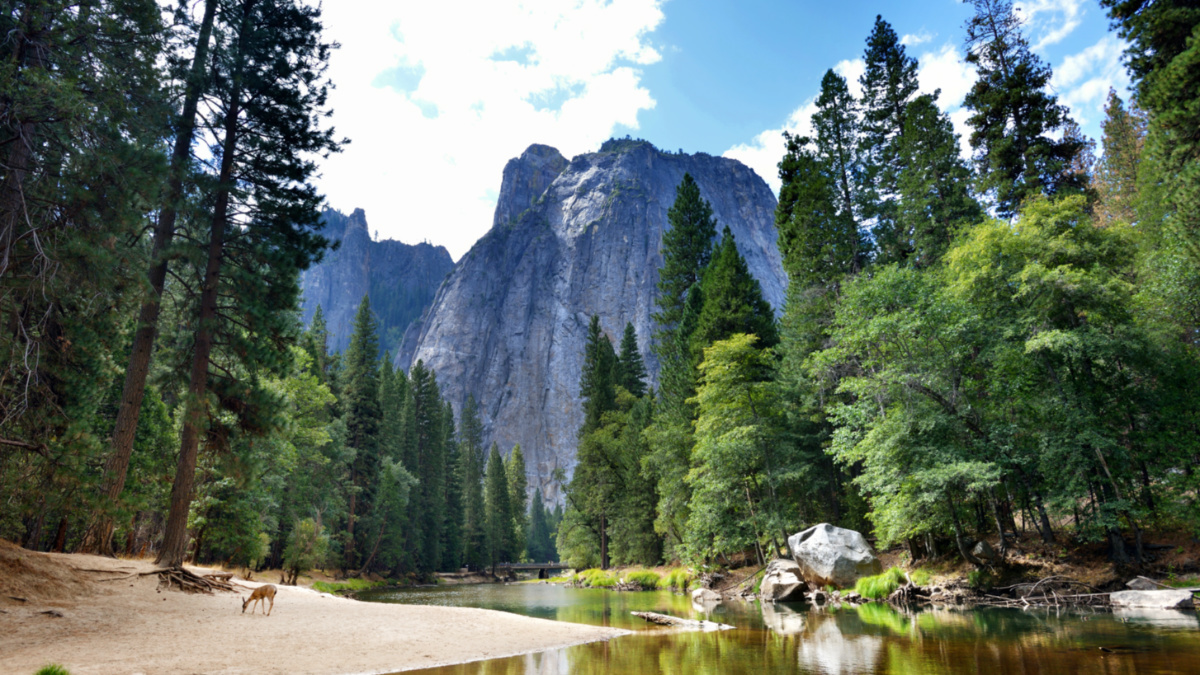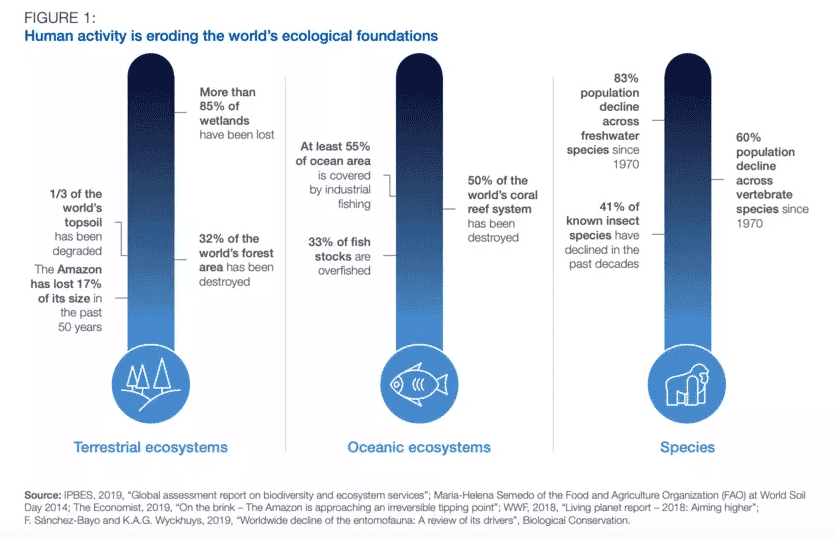
5 Reasons Why Biodiversity Matters – to Human Health, the Economy and Your Wellbeing

Biodiversity – the diversity within species, between species and of ecosystems – is declining globally, faster than at any other time in human history. Csondy / Getty Images
By Marie Quinney
Biodiversity is critically important – to your health, to your safety and, probably, to your business or livelihood.
But biodiversity – the diversity within species, between species and of ecosystems – is declining globally, faster than at any other time in human history. The world’s 7.6 billion people represent just 0.01% of all living things by weight, but humanity has caused the loss of 83% of all wild mammals and half of all plants. (Biodiversity loss and ecosystem collapse is one of the top five risks in the World Economic Forum’s 2020 Global Risks Report, too.)
In celebration of the International Day for Biological Diversity, we break down the five ways in which biodiversity supports our economies and enhances our wellbeing – and has the potential to do even more.
1. Biodiversity Ensures Health and Food Security.
Biodiversity underpins global nutrition and food security. Millions of species work together to provide us with a large array of fruits, vegetables and animal products essential to a healthy, balanced diet – but they are increasingly under threat.
Every country has indigenous produce – such as wild greens and grains – which have adapted to local conditions, making them more resilient to pests and extreme weather. In the past, this produce provided much-needed micronutrients for local populations. Unfortunately, however, the simplification of diets, processed foods and poor access to food have led to poor-quality diets. As a result, one-third of the world suffers from micronutrient deficiencies.
Three crops – wheat, corn and rice – provide almost 60% of total plant-based calories consumed by humans. This leads to reduced resiliency in our supply chains and on our plates. For example, the number of rice varieties cultivated in Asia has dropped from tens of thousands to just a few dozen; in Thailand, 50% of land used for growing rice only produces two varieties.
People once understood that the conservation of species was crucial for healthy societies and ecosystems. We must ensure this knowledge remains part of our modern agricultural and food systems to prevent diet-related diseases and reduce the environmental impact of feeding ourselves.
2. Biodiversity Helps Fight Disease.
Higher rates of biodiversity have been linked to an increase in human health.
First, plants are essential for medicines. For example, 25% of drugs used in modern medicine are derived from rainforest plants while 70% of cancer drugs are natural or synthetic products inspired by nature. This means that every time a species goes extinct, we miss out on a potential new medicine.
Second, biodiversity due to protected natural areas has been linked to lower instances of disease such as Lyme disease and malaria. While the exact origin of the virus causing COVID-19 is still unknown, 60% of infectious diseases originate from animals and 70% of emerging infectious diseases originate from wildlife. As human activities encroach upon the natural world, through deforestation and urbanization, we reduce the size and number of ecosystems. As a result, animals live in closer quarters with one another and with humans, creating ideal conditions for the spread of zoonotic diseases.
Simply put: more species means less disease.

Human activity is eroding biodiversity. World Economic Forum Nature Risk Rising
3. Biodiversity Benefits Business.
According to the World Economic Forum’s recent Nature Risk Rising Report, more than half of the world’s GDP ( trillion) is highly or moderately dependent on nature. Many businesses are, therefore, at risk due to increasing nature loss. Global sales of pharmaceuticals based on materials of natural origin are worth an estimated billion a year, while natural wonders such as coral reefs are essential to food and tourism.
There is great potential for the economy to grow and become more resilient by ensuring biodiversity. Every dollar spent on nature restoration leads to at least of economic benefits. In addition, changing agricultural and food production methods could unlock .5 trillion per year in new business opportunities by 2030, while also preventing trillions of dollars’ worth of social and environmental harms.
4. Biodiversity Provides Livelihoods.
Humans derive approximately 5 trillion of value from natural ecosystems each year. Globally, three out of four jobs are dependent on water while the agricultural sector employs over 60% of the world’s working poor. In the Global South, forests are the source of livelihoods for over 1.6 billion people. In India, forest ecosystems contribute only 7% to India’s GDP yet 57% of rural Indian communities’ livelihoods.
Ecosystems, therefore, must be protected and restored – not only for the good of nature but also for the communities that depend on them.
Although some fear environmental regulation and the safeguarding of nature could threaten businesses, the “restoration economy” – the restoration of natural landscapes – provides more jobs in the United States than most of the extractives sector, with the potential to create even more. According to some estimates, the restoration economy is worth billion per year and directly employs more than the coal, mining, logging and steel industries altogether. Nature-positive businesses can provide cost-effective, robot-proof, business-friendly jobs that stimulate the rural economy without harming the environment.
5. Biodiversity Protects Us.
Biodiversity makes the earth habitable. Biodiverse ecosystems provide nature-based solutions that buffer us from natural disasters such as floods and storms, filter our water and regenerate our soils.
The clearance of over 35% of the world’s mangroves for human activities has increasingly put people and their homes at risk from floods and sea-level rise. If today’s mangroves were lost, 18 million more people would be flooded every year (an increase of 39%) and annual damages to property would increase by 16% ( billion).
Protecting and restoring natural ecosystems is vital to fighting climate change. Nature-based solutions could provide 37% of the cost-effective CO2 mitigation needed by 2030 to maintain global warming within 2°C (35.6 F).
Natural ecosystems provide the foundations for economic growth, human health and prosperity. Our fate as a species is deeply connected to the fate of our natural environment.
As ecosystems are increasingly threatened by human activity, acknowledging the benefits of biodiversity is the first step in ensuring that we look after it. We know biodiversity matters. Now, as a society, we should protect it – and in doing so, protect our own long-term interests.
Reposted with permission from World Economic Forum.
- World Leaders, Media Ignore Biodiversity Report Detailing Mass ...
- 15 Indigenous Crops to Boost Your Immune System and Celebrate ...
- Why Biodiversity Loss Hurts Humans as Much as Climate Change ...
- Ocean Scientists Create Global Network to Help Save Biodiversity - EcoWatch
- Scientists Launch ‘Four Steps for Earth’ to Protect Biodiversity - EcoWatch
- Rethink Global Economy to Halt Mass Extinction, Study Argues

 233k
233k  41k
41k  Subscribe
Subscribe 